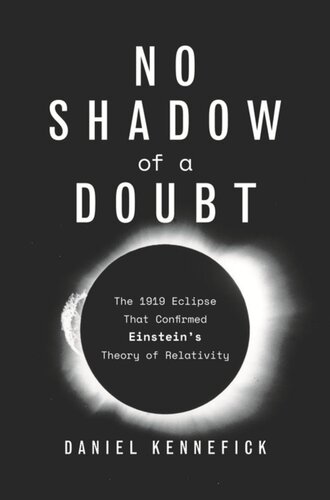

Most ebook files are in PDF format, so you can easily read them using various software such as Foxit Reader or directly on the Google Chrome browser.
Some ebook files are released by publishers in other formats such as .awz, .mobi, .epub, .fb2, etc. You may need to install specific software to read these formats on mobile/PC, such as Calibre.
Please read the tutorial at this link: https://ebookbell.com/faq
We offer FREE conversion to the popular formats you request; however, this may take some time. Therefore, right after payment, please email us, and we will try to provide the service as quickly as possible.
For some exceptional file formats or broken links (if any), please refrain from opening any disputes. Instead, email us first, and we will try to assist within a maximum of 6 hours.
EbookBell Team

4.3
8 reviewsThe first authoritative account of the 1919 solar eclipse expedition that confirmed the theory of general relativity and instantly made Einstein a global celebrity.
On their 100th anniversary, the story of the extraordinary scientific expeditions that ushered in the era of relativity
In 1919, British scientists led extraordinary expeditions to Brazil and Africa to test Albert Einstein’s revolutionary new theory of general relativity in what became the century’s most celebrated scientific experiment. The result ushered in a new era and made Einstein a global celebrity by confirming his dramatic prediction that the path of light rays would be bent by gravity. Today, Einstein’s theory is scientific fact. Yet the effort to “weigh light” by measuring the gravitational deflection of starlight during the May 29, 1919, solar eclipse has become clouded by myth and skepticism. Could Arthur Eddington and Frank Dyson have gotten the results they claimed? Did the pacifist Eddington falsify evidence to foster peace after a horrific war by validating the theory of a German antiwar campaigner? In No Shadow of a Doubt, Daniel Kennefick provides definitive answers by offering the most comprehensive and authoritative account of how expedition scientists overcame war, bad weather, and equipment problems to make the experiment a triumphant success.
The reader follows Eddington on his voyage to Africa through his letters home, and delves with Dyson into how the complex experiment was accomplished, through his notes. Other characters include Howard Grubb, the brilliant Irishman who made the instruments; William Campbell, the American astronomer who confirmed the result; and Erwin Findlay-Freundlich, the German whose attempts to perform the test in Crimea were foiled by clouds and his arrest.
By chronicling the expeditions and their enormous impact in greater detail than ever before, No Shadow of a Doubt reveals a story that is even richer and more exciting than previously known.